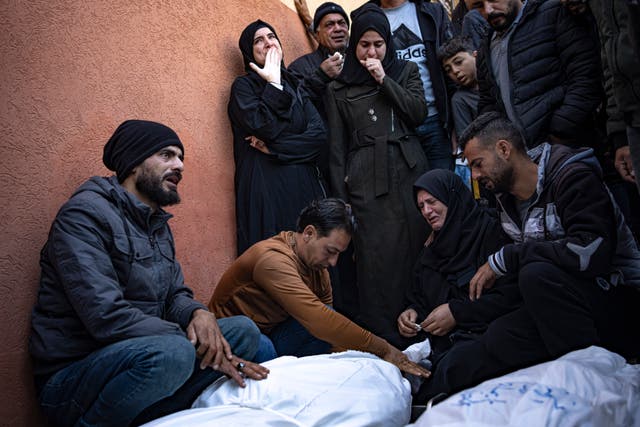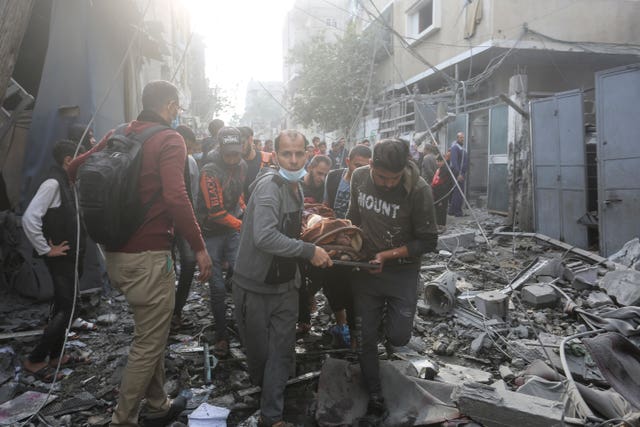
The death toll in the Gaza Strip during fighting with Israel has passed 15,200 and about 70% were women and children, according to the territory’s Health Ministry.
The figure was announced on Saturday by ministry spokesman Ashraf al-Qidra, who did not provide further details.
The previous toll given by the ministry was more than 13,300.
 Palestinians look at destruction after the Israeli bombing in Khan Younis refugee camp (Mohammed Dahman/AP)
Palestinians look at destruction after the Israeli bombing in Khan Younis refugee camp (Mohammed Dahman/AP)
Mr al-Qidra did not explain the sharp jump, although the ministry had only been able to provide sporadic updates since November 11 amid problems with connectivity and major war-related disruption in hospital operations.
The ministry does not differentiate between civilians and combatants.
More than 40,000 people have been wounded, Mr al-Qidra said.
Israel has intensified a renewed offensive that followed a week-long truce with Hamas, giving rise to renewed concerns about civilian casualties, even as the US urged ally Israel to do everything possible to protect civilians.
“This is going to be very important going forward,” secretary of state Antony Blinken said on Friday after meetings with Arab foreign ministers in Dubai, wrapping up his third Middle East tour since the war started. “It’s something we’re going to be looking at very closely.”
Many of Israel’s attacks on Saturday were focused on the Khan Younis area in southern Gaza, where the military said it had struck more than 50 Hamas targets with air strikes, tank fire and its navy.
The military dropped leaflets the day before warning residents to leave but by late Friday there had been no reports of large numbers of people leaving, according to the United Nations.
 Palestinians mourn relatives killed in the Israeli bombardment (Fatima Shbair/AP)
Palestinians mourn relatives killed in the Israeli bombardment (Fatima Shbair/AP)
“There is no place to go,” said Emad Hajar, who fled with his wife and three children from the northern town of Beit Lahia a month ago to seek refuge in Khan Younis.
“They expelled us from the north, and now they are pushing us to leave the south.”
Israel’s military said it also carried out strikes in the north, and hit more than 400 targets across the Gaza Strip.
Two million people — almost Gaza’s entire population — are crammed into the territory’s south, where Israel urged people to relocate at the war’s start and has since vowed to extend its ground assault.
Unable to go into north Gaza or neighbouring Egypt, their only escape is to move around within the 85 square mile area.
In response to US calls to protect civilians, the Israeli military released an online map, but it has done more to confuse than to help.
It divides the Gaza Strip into hundreds of numbered, haphazardly drawn parcels, sometimes across roads or blocks, and asks residents to learn the number of their location in case of an eventual evacuation.
 Palestinians evacuate wounded in Rafah (Hatem Ali/AP)
Palestinians evacuate wounded in Rafah (Hatem Ali/AP)
“The publication does not specify where people should evacuate to,” the UN office for co-ordinating humanitarian issues in the Palestinian territory said in its daily report. “It is unclear how those residing in Gaza would access the map without electricity and amid recurrent telecommunications cuts.”
In the first use of the map to order evacuations, Avichay Adraee, the Israeli military’s Arabic spokesperson, specified areas in the north and the south to be cleared out Saturday.
He tweeted a list of numbered zones under evacuation order, but the highlighted areas on maps attached to his post did not match the numbered zones.
Egypt has expressed concerns that the renewed offensive could cause Palestinians to try to cross into its territory. In a statement late on Friday, the Foreign Ministry said the forced transfer of Palestinians “is a red line”.
The renewed hostilities have also heightened concerns for 136 hostages who, according to the Israeli military, are still held captive by Hamas and other militants after 105 were freed during the truce.
For families of remaining hostages, the truce’s collapse was a blow to hopes their loved ones could be the next out after days of seeing others freed. The Israeli army said on Friday that it had confirmed the deaths of four more hostages, bringing the total known dead to seven.
During the truce, Israel freed 240 Palestinians from its prisons. Most of those released from both sides were women and children.


Comments: Our rules
We want our comments to be a lively and valuable part of our community - a place where readers can debate and engage with the most important local issues. The ability to comment on our stories is a privilege, not a right, however, and that privilege may be withdrawn if it is abused or misused.
Please report any comments that break our rules.
Read the rules here